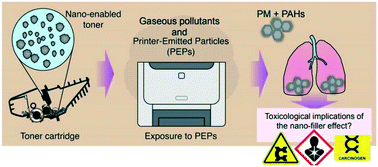当前位置:
X-MOL 学术
›
Environ. Sci.: Nano
›
论文详情
Our official English website, www.x-mol.net, welcomes your feedback! (Note: you will need to create a separate account there.)
Synergistic effects of engineered nanoparticles and organics released from laser printers using nano-enabled toners: potential health implications from exposures to the emitted organic aerosol
Environmental Science: Nano ( IF 7.3 ) Pub Date : 2017-08-30 00:00:00 , DOI: 10.1039/c7en00573c Marie-Cecile G. Chalbot 1, 2, 3, 4 , Sandra V. Pirela 5, 6, 7, 8, 9 , Laura Schifman 4, 10, 11, 12 , Varun Kasaraneni 4, 10, 11, 12 , Vinka Oyanedel-Craver 4, 10, 11, 12 , Dhimiter Bello 5, 6, 7, 8, 9 , Vincent Castranova 4, 13, 14, 15 , Yong Qian 4, 15, 16, 17, 18 , Treye Thomas 4, 19, 20, 21 , Ilias G. Kavouras 1, 2, 3, 4 , Philip Demokritou 5, 6, 7, 8, 9
Environmental Science: Nano ( IF 7.3 ) Pub Date : 2017-08-30 00:00:00 , DOI: 10.1039/c7en00573c Marie-Cecile G. Chalbot 1, 2, 3, 4 , Sandra V. Pirela 5, 6, 7, 8, 9 , Laura Schifman 4, 10, 11, 12 , Varun Kasaraneni 4, 10, 11, 12 , Vinka Oyanedel-Craver 4, 10, 11, 12 , Dhimiter Bello 5, 6, 7, 8, 9 , Vincent Castranova 4, 13, 14, 15 , Yong Qian 4, 15, 16, 17, 18 , Treye Thomas 4, 19, 20, 21 , Ilias G. Kavouras 1, 2, 3, 4 , Philip Demokritou 5, 6, 7, 8, 9
Affiliation

|
Recent studies have shown that engineered nanoparticles (ENPs) are incorporated into toner powder used in printing equipment and released during their use. Thus, understanding the functional and structural composition and the potential synergistic effects of this complex aerosol and released gaseous co-pollutants is critical in assessing their potential toxicological implications and risks. In this study, toner powder and PEPs were thoroughly examined for the functional and molecular composition of the organic fraction and the concentration profile of 16 Environmental Protection Agency (EPA)-priority polycyclic aromatic hydrocarbons (PAH) using state-of-the-art analytical methods. Results show significant differences in abundance of the non-exchangeable organic hydrogen of toner powder and PEPs, with a stronger aromatic spectral signature in PEPs. Changes in the structural composition of PEPs are indicative of radical additions and free-radical polymerization favored by catalytic reactions, resulting in formation of functionalized organic species. Particularly, accumulation of aromatic carbons with strong styrene-like molecular signatures on PEPs is associated with formation of semi-volatile heavier aromatic species (i.e., PAHs). Further, the transformation of low molecular weight PAHs in the toner powder to high molecular weight PAHs in PEPs was documented and quantified. This may be a result of synergistic effects from catalytic metal/metal oxide ENPs incorporated into the toner and the presence/release of semi-volatile organic species (SVOCs). The presence of known carcinogenic PAHs on PEPs raises public health concerns and warrants further toxicological assessment.
中文翻译:

使用纳米墨粉从激光打印机释放的工程纳米颗粒和有机物的协同效应:暴露于排放的有机气溶胶对健康的潜在影响
最近的研究表明,工程纳米颗粒(ENP)被掺入打印设备中使用的墨粉中,并在使用过程中释放出来。因此,了解这种复杂的气溶胶和释放出的气态共同污染物的功能和结构组成以及潜在的协同作用,对于评估其潜在的毒理学意义和风险至关重要。在这项研究中,使用最新的分析技术,彻底检查了碳粉和PEP的有机部分的功能和分子组成以及16种环境保护局(EPA)优先级多环芳烃(PAH)的浓度分布方法。结果表明,碳粉和PEP中不可交换的有机氢丰度存在显着差异,PEP中的芳香族光谱特征更强。PEPs结构组成的变化表明催化反应有利于自由基加成和自由基聚合,导致形成官能化的有机物质。特别是,PEP上具有强苯乙烯样分子标记的芳族碳的积累与半挥发性重芳族物质的形成有关(即PAHs)。此外,记录并定量了调色剂粉末中的低分子量PAHs向PEP中的高分子量PAHs的转变。这可能是由于掺入墨粉中的催化金属/金属氧化物ENP产生协同效应以及半挥发性有机物(SVOC)的存在/释放的结果。PEP上存在已知致癌的PAH引起了公众健康的关注,并需要进行进一步的毒理学评估。
更新日期:2017-11-09
中文翻译:

使用纳米墨粉从激光打印机释放的工程纳米颗粒和有机物的协同效应:暴露于排放的有机气溶胶对健康的潜在影响
最近的研究表明,工程纳米颗粒(ENP)被掺入打印设备中使用的墨粉中,并在使用过程中释放出来。因此,了解这种复杂的气溶胶和释放出的气态共同污染物的功能和结构组成以及潜在的协同作用,对于评估其潜在的毒理学意义和风险至关重要。在这项研究中,使用最新的分析技术,彻底检查了碳粉和PEP的有机部分的功能和分子组成以及16种环境保护局(EPA)优先级多环芳烃(PAH)的浓度分布方法。结果表明,碳粉和PEP中不可交换的有机氢丰度存在显着差异,PEP中的芳香族光谱特征更强。PEPs结构组成的变化表明催化反应有利于自由基加成和自由基聚合,导致形成官能化的有机物质。特别是,PEP上具有强苯乙烯样分子标记的芳族碳的积累与半挥发性重芳族物质的形成有关(即PAHs)。此外,记录并定量了调色剂粉末中的低分子量PAHs向PEP中的高分子量PAHs的转变。这可能是由于掺入墨粉中的催化金属/金属氧化物ENP产生协同效应以及半挥发性有机物(SVOC)的存在/释放的结果。PEP上存在已知致癌的PAH引起了公众健康的关注,并需要进行进一步的毒理学评估。



























 京公网安备 11010802027423号
京公网安备 11010802027423号